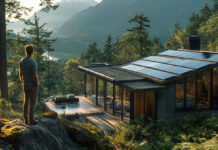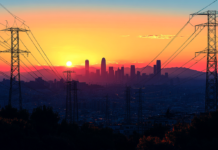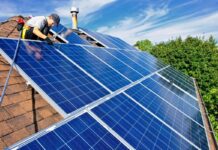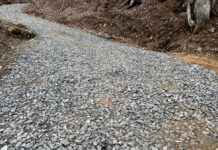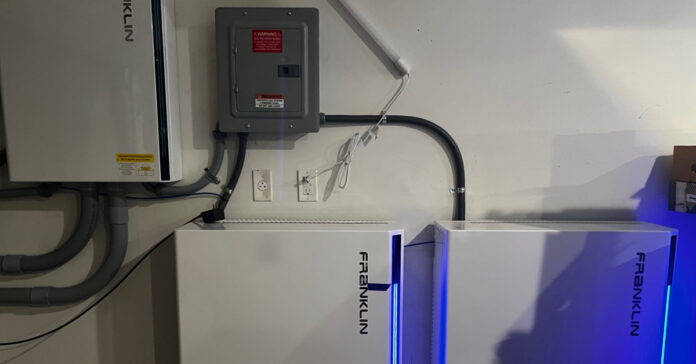
For the first time since it was installed this summer, our solar system meets the specs we were quoted during the sales process. We can now use the generator to charge the batteries during periods when there is little or no sun. It took two months dealing with the installer and manufacturer to make a warranty claim, get a replacement component, and have a service team from the installer visit to install it. (In hindsight, I could have done it myself, but that would probably have broken the warranty or something.) Thankfully, it didn’t cost me anything but my time, and the rest of our system worked normally during this period.
After this repair, my hope is things will now run seamlessly for years. No guarantee, of course. Electronics fail, which is why the components in system have 10 and 12-year warranties.
I can say from experience the technical support people at Franklin WH are excellent and willingly invested hours resolving the issue.
Winter Storms
As winter storm after storm peppers the United States (we’re in one as I write this and another is expected Wednesday and Thursday), it should be no surprise that the amount of power our solar power system is producing is less than half what we produced in July and August.
Not only do we need sunlight to make power, something that has been in short supply with the bad weather, but the panels don’t work when covered with a layer of snow. Our Starlink internet antenna has a great feature that heats the surface of the device, melting off the snow. Our solar panels lack a similar function. Of course, it might consume more power than it produces, which would be a non-starter. So we rely on sunlight to melt the snow, which it does. Eventually.
Our electric bill was $72 last month, the highest since we installed the system. It would be far more if we didn’t heat with wood. Still, it’s less than half of what we paid this time last year. February should be better.
On the brightest day so far in February, we produced 38 kWh, which is close to a 20 percent improvement over what we produced on our best day in January. We need more days like that. January was a snowy, rainy, and cloudy month and produced 30 percent less electricity than November. So far, February is off to a better start, or was until the recent storms hit. Plus, the extra few minutes of sunlight every day are adding up and making a difference. The other day, our panels were producing 500 watts of power at 5 p.m. Last month, they stopped producing power as early as 3:30.
Seasonal Variations
Our solar power production is more than sufficient in the summer months when we have up to 15 hours of sunlight. It is insufficient when we have less than 10 hours, like in January.
If we were off grid and relying on solar to power our home, I calculate we would need another six panels, producing up to 2.4 kW every hour to boost our winter production to a suitable level. The additional panels would also necessitate a larger inverter. With that size system, we would be squeaking by in the winter, but producing more power than we needed in the summer.
For off-grid use, we would also need to double or even triple our battery capacity. Lots of batteries are the key to not running out of power when there is no sun for a few days.
Had we built a system from scratch with six more panels, a larger inverter, and four more batteries, it would have more than doubled our cost. For financial reasons, we settled on pretty good rather than perfect. It’s a compromise, but so much in life is.
Grid-Down Scenario
The grid went gone down five times in the past week, thanks to an ice storm and high winds. Since no outage has lasted more than six hours, our batteries have handled it just fine. An outage of more than 24 hours would have been another story.
When we expect outages, we put our system in Emergency Backup mode. This charges the batteries to 100 percent using solar and/or grid power. Then it keeps the batteries fully charged. After an outage, it immediately recharges the batteries. This was a big help when we had multiple outages the day of the ice storm. In the middle of a storm, the panels don’t make enough power to keep up. For example, on Sunday, we made only 4kWh, about a seventh of what we consumed. Having the ability to recharge the batteries using grid power is useful, especially in bad weather.
During a lengthy or permanent grid-down scenario in the winter, we would have to conserve power, much as we did after Hurricane Helene. I’d run the generator only if I knew we could get gasoline re-supply. If this was a serious SHTF scenario with no resupply possible, we would limit our use of 30-amp appliances to days of full sun. I would also consider unplugging the fridge and freezer and storing food on the deck in ice chests when it is cold enough. That would save three or four kWh per day. On a sunny day, once the batteries are close to full, we could use those power-hungry appliances and cook something in the oven or run the dishwasher. On the cloudy and snowy days, we’d be watching every watt and wearing headlamps to conserve power.
Off Grid Living
If you want to live completely off gird, my advice would be to oversize your solar power system so it provides sufficient power for you to live comfortably in the winter. That’s a bigger upfront cost, but it’s that or invest in a powerful generator and sufficient fuel to produce half your power needs. My gas-powered portable generator is fine for occasional use, but I’d go with a military surplus diesel generator and a 278-gallon tank of fuel if I expected to run it regularly. Another option would be a propane generator and at least a 500 gallon tank.
Of course, if you build off grid, you would spec a propane oven, cooktop and hot water heater. Because our house was all-electric and has no propane on site, we didn’t have that option. That means we consume far more electricity than a house designed for off-grid living.
I Would do it Again
We’ve had our solar power system for seven months now, and I am glad we made the investment. I am also glad we stayed on the grid rather than opting to go off grid. Yes, we have to pay the utility a few bucks (less than $5 for sunny months), but we treat the grid like a big battery tap into whenever we need extra power. At the same time, we have our own batteries to provide power when the grid is down. It’s another compromise, but a good one so far.


